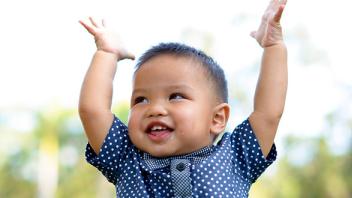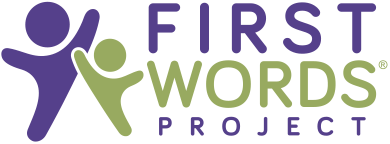Good communication development starts in the first year of life and goes far beyond learning how to talk. Communication development has its roots in social interaction with parents and other caregivers during everyday activities.
Your child’s growth in social communication is important because it helps your child connect with you, learn language and play concepts, and sets the stage for learning to read and future success in school. Good communication skills are the best tool to prevent behavior problems and make it easier to work through moments of frustration that all infants and toddlers face.
By observing children’s early gestures, you can obtain a critical snapshot of their communication development. Even small lags in communication milestones can add up and impact a child’s rate of learning that is difficult to change later.
Research with young children indicates that the development of gestures from 9 to 16 months predicts language ability two years later, which is significant because preschool language skills predict academic success. So it’s important to remember that by 16 months, children should have at least 16 gestures.
Let’s consider how gestures develop. While the order or specific gestures may vary slightly, children should be using at least two new gestures each month between 9 and 16 months.
Children should learn at least 16 gestures by 16 months
My Baby Navigator
When you join My Baby Navigator, you’ll have access to resources and tools that are customized for your baby’s age and grow as your baby grows to help monitor development — birth to 24 months. From Lookbooks to Growth Charts, from Monthly Check-Ins to our Social Communication CheckUp, from Printables to Web Resources — all in one place that you can access online from anywhere anytime.
9 months: give, shake head
At 9 months, children’s earliest gestures begin to develop from their actions — and the reactions of others. Children first learn to take an object. Then, as they are able to control their hand movements to release and drop an object, they gain experience from their parent holding out their hand to catch it — and they learn to give.
Children learn to shake their head to indicate “no” by turning away from food they do not like and then looking back to see their parent respond by moving the undesired food away.
10 months: reach, raise arms
At 10 months, children learn to reach through exploration and experiences with others, as they reach to take an object and to be picked up.
As they learn to anticipate the reactions of others, they use a reach gesture as a signal — first, with their arm reaching out, then, with their open hand facing up, and with their arms raised to ask to be picked up.
11 months: show, wave
At 11 months, children are motivated to share their interests with others. They learn to hold up and show objects to get others to look and notice what they’re interested in.
Children are also motivated by the social experience of greeting in everyday routines where special people are coming and going. They learn to wiggle their hand to wave, with a mature wave developing later.
12 months: open-hand point and tap
At 12 months, children use an open-hand point with the fingers spread, and a tap with the fingers together, as an indicative gesture to draw the attention of others to things of interest. Children’s gestures become more clearly intentional and are often produced with emphasis and are now accompanied by grunts or early speech sounds.
13 months: clap, blow a kiss
At 13 months, children begin to learn through observation — by observing others and copying what they do and say. They learn to use gestures, such as to clap their hands and blow a kiss, by watching others and imitating them. The gestures and words children are exposed to shape their vocabulary and drive their interest in learning.
14 months: index finger point, “shhh” gesture
At 14 months, children point with the index finger to reference things at a distance, a sign that observational learning is solid and they are on the cusp of becoming a symbolic communicator. Children also use the index finger for the “shhh” gesture. Their growing repertoire of gestures propels the unfolding of spoken words.
15 months: head nod, thumbs up, hand up
At 15 months, you see symbolic gestures that are like words — a head nod or thumbs up to indicate “yes”, a wave in front of their face to indicate “stinky”, or a hand up to indicate “wait”. Gestures now reflect not only what the child is thinking about, but also that they know they are sharing ideas with others.
16 months: other symbolic gestures
At 16 months, other symbolic gestures develop — such as “I dunno”, “high 5”, or even the universal peace sign. Gestures now bolster the learning of spoken words.
Having 16 gestures is a critical milestone to launch language and learning
Watching the growth and sophistication of gestures tells you a lot about your child’s symbolic communication — and whether to be concerned if your child is not yet talking. While the specific gestures a child learns may vary depending on their family or culture, having 16 gestures by 16 months is a critical milestone for all children because it launches them from early first words into a vocabulary burst at 18 to 21 months. Children now get the idea that everything has a name and they learn new words rapidly.
The richest moments for early language learning are when the child and caregiver are sharing attention on the same thing and the caregiver talks about the child’s focus of attention, creating opportunities to learn that stem from social interaction. If a child is not using these early gestures, then the parent may not have the chance to respond and follow the child’s focus, which in turn limits the child’s opportunity for both language learning and social connectedness.
As a child’s gestures are developing between 9 and 16 months, you should also see other social communication milestones — the use of eye gaze and facial expressions to share attention and emotion, an increasing rate of communicating with sounds and gestures, a wider variety of actions in play, and an emerging ability to comprehend the meaning of spoken words.
If these early social communication milestones are not solidly in place, it is likely that language will be delayed. It is important to keep in mind that delays in many social communication milestones may indicate risk for autism or other developmental delays. By detecting small gaps in early social communication skills, you can get extra help to support your child’s development before significant delays are evident.
Want to learn more? Subscribe!
FIRST WORDS® Project is a longitudinal research investigation in the Florida State University Autism Institute, directed by Dr. Amy Wetherby. Our goal is to identify early signs of communication delays in young children by improving screening tools and helping families support child development. Copyright © 2019 Florida State University. All rights reserved.
Developed by the FIRST WORDS® Project. www.firstwordsproject.com
© 2014 Florida State University. All rights reserved.

